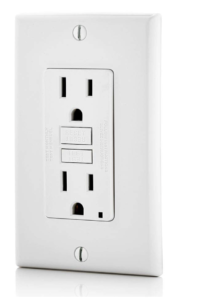 Arc Fault Circuit Interrupters (AFCI) are circuit breakers required for specific circuits throughout the home. They add an extra layer of protection against arcing conditions that could start fires at the electrical panel.Rather than only detecting overloads and short circuits—which simply shut off the breaker—AFCI breakers are always on the hunt for any type of dangerous arc and working to minimize the impact on the electrical system. A common example of an outlet with an AFCI will have the test/reset buttons on it.
Arc Fault Circuit Interrupters (AFCI) are circuit breakers required for specific circuits throughout the home. They add an extra layer of protection against arcing conditions that could start fires at the electrical panel.Rather than only detecting overloads and short circuits—which simply shut off the breaker—AFCI breakers are always on the hunt for any type of dangerous arc and working to minimize the impact on the electrical system. A common example of an outlet with an AFCI will have the test/reset buttons on it.
During a full home inspection with HomeTech, we inspect the entire electrical system and make recommendations to ensure the safety of people living within the home. As a reminder, you don’t need to be buying or selling a house to have an inspection – we do inspections for buyers, sellers or even homeowners looking to learn more about issues within their home.
Facts about Arc Fault Circuit Interrupters: courtesy of the Electrical Safety Foundation
- Many home electrical fires are started by arcing faults, What is an Arching fault? “Arcing faults happen when electrical wiring becomes damaged, stressed, overheated or worn. The term “arc fault” refers to a situation in which loose or corroded wiring connections create an intermittent contact that causes an electrical current to spark, or arc, between metal contact points. When you hear a light switch or outlet buzzing or hissing, you are hearing arcing as it happens.” source
- Wiring inside the wall can be damaged by nails, screws, or drill bits that are being used on the wall, like when hanging a picture.
- Wiring inside extension and electrical cords can be damaged when pinched by heavy furniture and doors, or when staples used to hold them cut or pinch the cord’s insulation.
- Placing extension cords inside walls or under carpets can cause them to overheat, which could also cause an arc fault.
- The most common AFCIs are advanced circuit breakers that replace the standard breakers in your home’s electrical service panel.
- Outlet AFCIs provide protection to power cords and things that are plugged into the receptacle.
- AFCIs detect hazardous arcing conditions and shut down the electricity before a fire can start.
- The current edition of the National Electrical Code (NEC) requires that AFCIs be installed in the bedrooms and living areas of all newly constructed homes.
- Standard circuit breakers in existing homes can easily be upgraded to AFCIs.
- AFCIs should be installed by a licensed, qualified electrician.
- Once installed, AFCIs need to be tested every month to ensure they are working properly.
 AFCI Q&A
AFCI Q&A
How do I know if I have AFCIs installed in my home?
Open your home electrical service panel and look at your circuit breakers. Do your breakers have a TEST button on them? Both AFCI and ground fault circuit interrupter (GFCI) breakers have TEST buttons, but standard breakers do not. If you see the TEST button, read the sticker attached to the breaker to find out if it is an AFCI or GFCI breaker.
I have seen AFCI testing devices sold in stores. Are they more reliable than the “test” button on the AFCI?
The TEST button on the AFCI is the best way to make sure your AFCIs are working properly. Instruments sold as AFCI “indicators” or “testers” may not work with all types or brands of AFCIs.
What’s the difference between an AFCI and a GFCI?
GFCIs are designed to protect people from electric shock. AFCIs protect against electrical fires caused by dangerous arcing faults.
Why do different states have different requirements for AFCIs?
Although AFCI requirements have been included in the National Electrical Code (NEC) since the 2005 edition, each state has the discretion to adopt the NEC as a whole or in part, and the adoption process differs in each state. Check with your state to find out what edition of the NEC is currently being used and whether the most current AFCI requirements were included in the adoption

